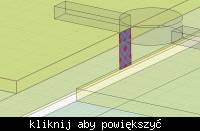Lumpport in HFSS...the excitation is applied at a point?
时间:03-31
整理:3721RD
点击:
Hi!
"With lump port=> the excitation is applied at a point/cell, as a voltage or current.
With wave-port=> the excitation is so-called eigen-wave, such as the quasi-tem wave supported by a microstrip line. It applies over a cross-sectional area.
voltage is scalar, wave is vector by nature, hence there are substantial difference between the two. So use waveport whenever possible, because "simulation of wave phenomenon" is what HFSS is designed for. And compare with the "correct" measurement whenever possible (i.e. measure "wave", not simply "voltage").
Why lumped port is there? It is easy to applied and people found that good/reasonable results can be obtained. Why? if the frequency is low enough or the excitation is applied at sufficiently small area, then the "wave" can be described by some "voltage" or "current", which must be "measured"/"calculated"/de-embedded/etc in the correct manner.
if the excitation can be applied on some locally uniform region=>waveport,
if geometry/material discontinuities are near/closer to the point of excitation=>lumped port might be the only way.
The subject of lumped vs wave port is actually complicated. people continue to study related matters, (e.g. arguing what is the "characteristic impedance").
Reading about the various de-embedding scheme should help with the understanding...."
--------------------------------------
1.As fig1,can I see the "point/cell" of lumpport feed in the geometry?
2.If my device pin is very narrow,What the size of lumpport need?
OR
OR another?
Thank you
-CQCQ
"With lump port=> the excitation is applied at a point/cell, as a voltage or current.
With wave-port=> the excitation is so-called eigen-wave, such as the quasi-tem wave supported by a microstrip line. It applies over a cross-sectional area.
voltage is scalar, wave is vector by nature, hence there are substantial difference between the two. So use waveport whenever possible, because "simulation of wave phenomenon" is what HFSS is designed for. And compare with the "correct" measurement whenever possible (i.e. measure "wave", not simply "voltage").
Why lumped port is there? It is easy to applied and people found that good/reasonable results can be obtained. Why? if the frequency is low enough or the excitation is applied at sufficiently small area, then the "wave" can be described by some "voltage" or "current", which must be "measured"/"calculated"/de-embedded/etc in the correct manner.
if the excitation can be applied on some locally uniform region=>waveport,
if geometry/material discontinuities are near/closer to the point of excitation=>lumped port might be the only way.
The subject of lumped vs wave port is actually complicated. people continue to study related matters, (e.g. arguing what is the "characteristic impedance").
Reading about the various de-embedding scheme should help with the understanding...."
--------------------------------------
1.As fig1,can I see the "point/cell" of lumpport feed in the geometry?

2.If my device pin is very narrow,What the size of lumpport need?

OR

OR another?
Thank you
-CQCQ
